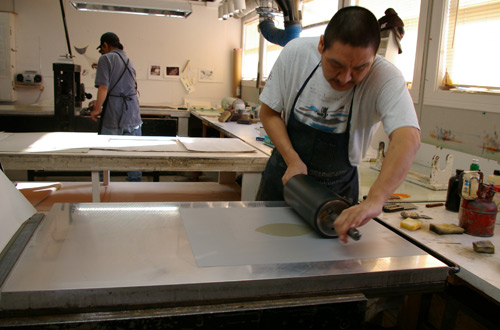Lithography
Lithography is a print technique that uses a flat print surface embedded with a thin film of chemicals, to which inks adhere. The antipathy of oil and water causes inks to stick to certain areas of the treated surface and to be repelled in other areas.
To make the printing surface, the printmaker (or in some cases the original artist) uses a grease pencil to draw a design onto a flat plate, typically an aluminum plate or a slab of special Bavarian limestone. A water-based solution of gum arabic is washed over the entire surface of the plate, adhering only to the areas not touched by the grease pencil. Using a turpentine solution, the printmaker removes the grease pencil marks, leaving behind the water-based gum arabic areas. He or she applies an oil-based ink over the entire surface of the print plate. The ink is washed and wiped off, but it sticks to the areas where the grease pencil was applied.

Printmaker Niviaqsi Quvianaqtuliaq creating a lithograph proof for "Halibut" by Ningeokuluk Teevee photo Norman Vorano, 2009, Photo © CMC
To make the paper print, the printmaker carefully lays a fresh sheet of blank paper on the print plate, which is washed with ink. With the assistance of a hand-cranked mechanical press, the printmaker squeezes the paper and print plate together under enormous pressure. This transfers the inks from the plate onto the paper. The inking and printing process is repeated many times to make a limited number of prints. The plate is then irrevocably cleaned with a different solution and reused for a new print.

